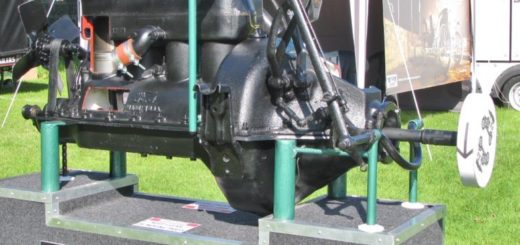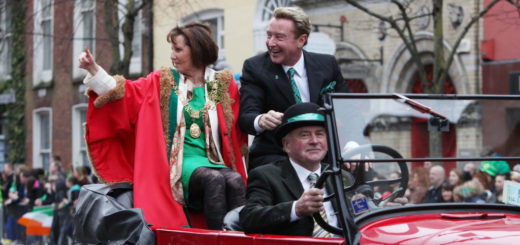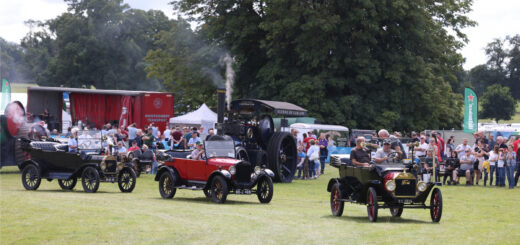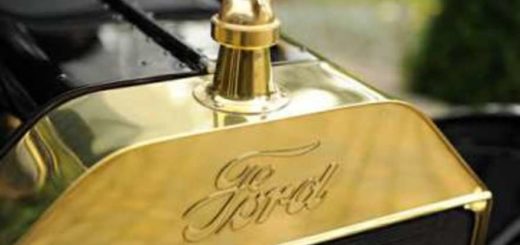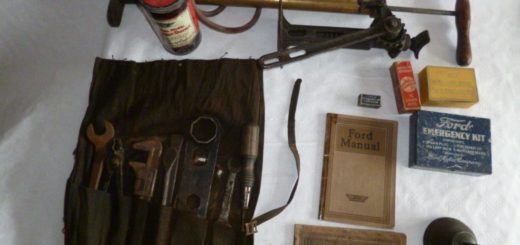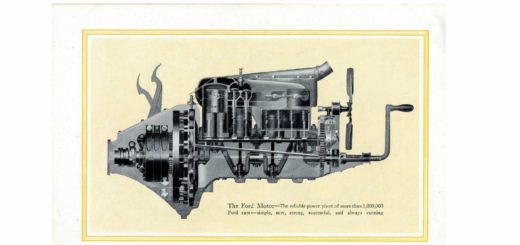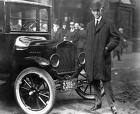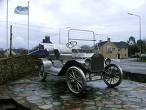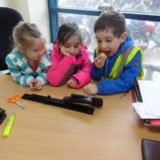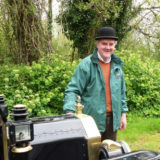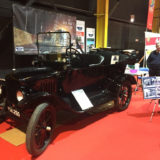Ballinadee 26th June 2022
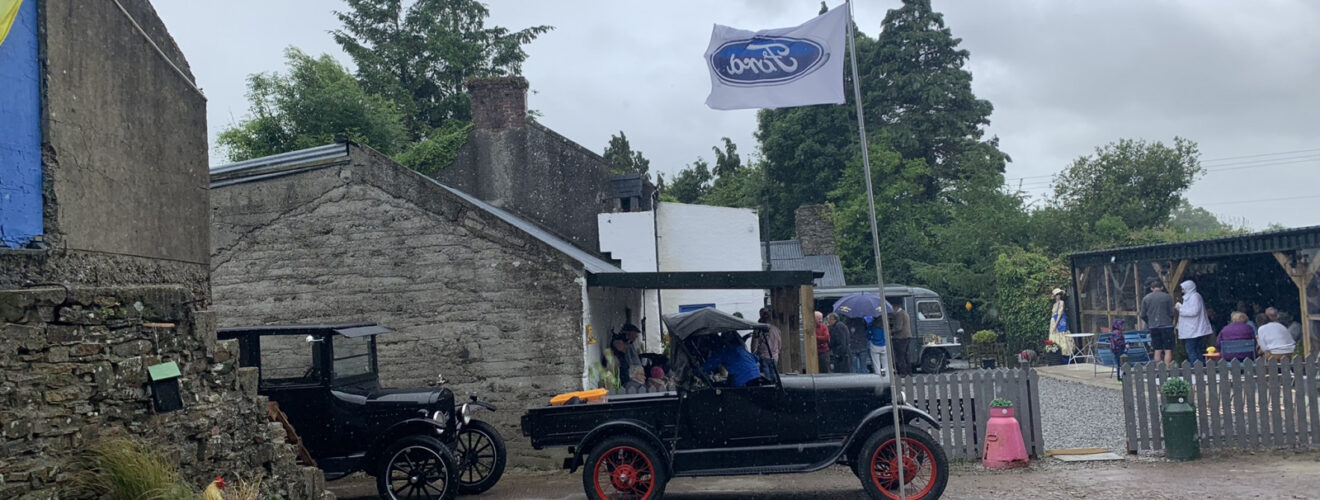
It is hard to believe that three years have passed since we were guests of the O’Neill family in Ballinadee. Much has happened since. We endured COVID 19 and for all intents and purpose we were shut down. What a pleasure it was for us all to back in the rhythm of runs and of course in delightful West Cork in mid June. We promised sunshine and dine weather, once again, and the Gods did not let us down.
What was a delight for us all, to meet the next generation of the O’Neill Clan. Catherine kindly brought her little family along to be introduced to us by very proud and loving grandparents John and Mary O’Neill. Darragh (8) and Cathal (4) were on hand to assist Grandad John deliver his drivers’ briefing after we had enjoyed morning refreshments in the refurbished community hall adjacent to the engineering works where we had all parked up our trailers and positioned our Ts in line ready for the off.
Our instructions were to proceed to Innishannon, taking the direct tree line road on the shores of the River Brandon and about a mile on the Cork side take a left and park up at a newly started quirky restaurant right in the middle of nowhere so to speak. Not quite really. We entered the retired farmyard to see a delightful resting spot for a cuppa and a sit down. The brainchild of UCC Economics graduate and foodie Francophile Siobhan Quirke, The Quirkey Kitchen is serving from an adorable vintage Citreon HY truck parked up.
It doesn’t hurt that Siobhan’s husband, Cork GAA star Sean Óg Ó’hAilpín, will be helping her out at the weekend, so you can swing by and get your takeaway Barry’s Tea poured by a sporting legend. But really, it’s all about celebrating the best of local food. “I was lucky to grow up in idyllic Innishannon and with West Cork being synonymous with artisanal and homegrown produce, it’s important to me to source and use local ingredients and suppliers where possible,” Siobhan told your correspondent. Business is brisk for the weekend trading and we were the first big group to enjoy our surprise stop.
Chris Larkin, a historian of transport, music and military was on hand to give us a glimpse of history of the Ford family connection. He himself had worked for many years in the Marina plant in Cork as well as in Germany and England. Chris has written a new book, to add to his collection, West Cork Railways, will be published by Mercer and available next October.
We then had the pleasure of the company of Alice Taylor. When she married she moved to Innishannon in 1961. There she ran a guesthouse, the local post office and a shop. In 1984 she edited and published a local magazine, Candlelight, and in 1986 she published an illustrated collection of her poetry. However it was her book To School Through the Fields, published in May 1988, which brought her fame. She had numerous interviews on national shows including RTÉ Radio’s The Gay Byrne Show and The Late Late Show.
The next books were equally successful and have been sold internationally. Since then she has moved onto novels which have also become best sellers. She recounted a train journey from Dublin with a stop over in Mallow to witness a rail preservation grouping. So impressed she was with the goings on of these she wrote a poem entitled “A Rusty Love Affair”
A Rusty Love Affair In a sun-baked shed With black-grained hands, These iron men of steam Sweat oil pursuing an ideal There she sits in state, Waiting for her archaic Limbs to be greased Into motion, her joints Soothed gently by her Black lovers, unquestioning In their complete adoration. In this brown station yard Carriages grey with old age, Retired queens proudly wear The grandeur of another day. Here, a dream in creation, An old train being reborn When men become gods Breathing life into dead iron.
Having chatted, tasted delightful home baking And enjoyed the mid morning sunshine in a delightful rural setting, then Ford flag was lowered, a signal to all that we were about to move on to our next stop. It was of course the Lusitania Museum and the Head Signal Tower. There we met with Shannon Forde, a UCC graduate in history who invited us to listen to her as she told us all about Ireland’s first restored Napolenoic Signal Tower number 25/out of a total count of 81 towers.
Visitors to some of Ireland’s most remote coastal locations might find themselves drawn to the sight of a lone grey tower, perched on an exposed hill-top or headland. These are the Napoleonic-era signal towers — central players in an early nineteenth century observation and communication system implemented in response to the threat of a French invasion of Ireland.
Initial plans
With initial plans mooted in 1803, the establishment of the signalling system began in earnest a year later when eighty-one strategic locations were initially identified as the sites for the signal stations. Between 1804 and 1806 most of the signal towers were constructed, furnished and staffed. Initial budgets were often surpassed, as building in such remote locations proved extremely difficult.
The towers themselves were a defensible quarters for the signal crew, which normally comprised a naval lieutenant, a midshipman, two signalmen and a military guard (usually between eight and twelve men in total). At some stations, however, there was no tower constructed — the crew instead being housed in a nearby Martello tower, light house or other fortification.
The Towers
Although local variation exists, the towers were all of broadly similar construction — square in plan, two (sometimes three) storeys high, flat roof with parapet, main door at first floor level (accessed by a ladder), and fireplaces. They also contained defensive features like machicolation (projections from the walls to allow objects to be thrown directly down on attackers). Their exteriors were rendered or weather-slated for protection against the elements, but even the earliest reports suggest that many suffered from damp and were difficult to maintain.
There may also have been smaller ancillary structures at these sites, and the remains of cultivation ridges at a number of towers suggest the crew were growing some of their own food. The whole complex was usually enclosed by a wall or sloping bank (glacis) which afforded some extra protection. Unlike their burly bigger brothers — the Martello towers — the signal towers were not designed to hold heavy artillery and provide cannon fire to protect strategic harbours and water routes. Their main role was to house their crew and help protect them from attack by a small force.
The Signalling System
The signalling system itself, referred to as an optical telegraph, was similar to that in use on the English coast at the time and required that signal stations were inter-visible with their counterparts at either side. The process of sending a message involved the raising and lowering of a large rectangular flag, a smaller blue pendant and four black balls or hoops in various combinations along a system centred on a tall wooden mast.
This mast was positioned at the seaward side of the tower and the main enclosure often fanned out to encompass a semi-circular area around this. The signal stations were not only in contact with each other, but also communicated with ships at sea and would have relayed messages to and from inland locations.
By 4:00 pm we had completed our picnics and consumed ice cream cones from The Signal Tower Café and were ready to be on our way back to base at Ballinadee. As is customary, we all posted for a group photograph. Our President Paul Murphy thanked our hosts John and Mary O’Neill for all the organising of this late spring run. West Cork lived up to our expectations. He thanked Alice Taylor for her brief talk and poem recitation “A Rusty Love Affair. He thanked historian Chris Larkin for his insight on the Ford Family and their Cork connection.
He also expressed our sincere thanks to Shannon Forde for her eloquent and knowledgeable presentation on Signal Tower 25. Paul was most appreciative of our tail end Charlie Bill Chambers whose services, happily, were not called upon. Also our two stewards Kevin and Eoin, who only because river boating was called off for today, were they available to us; and a splendid job they did at crucial junctions. On behalf of us all, Paul presented John with a hand turned timber bowl in grateful appreciation.
We made it back to base by 4:45 meaning those who travelled the most would surely get back to their garages in plenty of time. We had a great day; everyone looking good and happy; all Ts working well and without misadventure.
Thank you to the O’Neill clan. We will certainly return.

